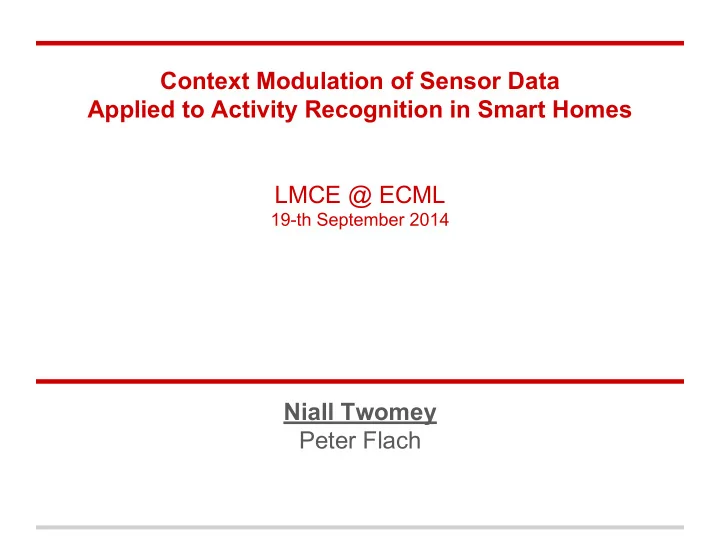

Context Modulation of Sensor Data Applied to Activity Recognition in Smart Homes LMCE @ ECML 19-th September 2014 Niall Twomey Peter Flach
SPHERE S ensing P latform for HE althcare in R esidential E nvironments Long-term goals ● Emergency detection ● Detection of health deterioration ● Rehabilitation assessment ● etc. http://www.irc-sphere.ac.uk
SPHERE Many research areas Healthcare Ecosystem ● Ethics ● Equip home with sensors ● Privacy ● Learn models to quantify the ● User acceptance goals ● User centred design Big, complex data ● Video, environment, on-body ● Eventually sensors
SPHERE ● Machine learning, data mining, Key idea data fusion etc. ● Long-term trends in activity may ● SPHERE data tell us something about health ○ Video ● Learn activity recognition models ○ On-body sensors with SPHERE data ○ Environment sensing Don’t have SPHERE data yet... ○ … ● Using surrogate datasets
CASAS C entre for A dvanced S tudies in A daptive S ystems ● Approx 20 datasets ● Variety of sensors ○ Motion ○ Door ○ Light ○ Temperature ○ Power ○ ... ● Activities of daily living ● Multiple inhabitants http://ailab.wsu.edu/casas/
Sensor data file
SPHERE: 100 Homes Deployment ● Difficulties Question: ○ 100 different houses What can we learn from the CASAS ○ Over 100 residents datasets now to help us with our ○ Over 100 habits/behaviours deployment later ? ● Want to ● Not necessarily as models, but ○ Reuse resources/models knowledge about domain ○ Learn global “lessons”
Context Modulation Context modulation is : Context modulation yields : “... the act of modifying and “...new representations are adapting datasets in such a way illustrative of original (user- that new topological defined) contexts... ” representations of the original Can we learn anything about the dataset are obtained...” problem from the performance of models learnt from modulated data?
Original context: 80 sensors approx Example: Topological Overview of Different Sensing Contexts
Original context: Context 1: 80 sensors approx 50 sensors approx Example: Topological Overview of Different Sensing Contexts
Original context: Context 1: Context 2: 80 sensors approx 50 sensors approx 7 sensors approx Example: Topological Overview of Different Sensing Contexts
Why? Sensors Labels ● Simulate breaking sensors ● Multi-resident environments (corrupt dataset) activities are similar; sharing ● Replace 6 sensors with one of variables different capabilities ● Represent database as a ● Effect of blind spots multitask problem ● Optimise sensor distribution ● Transfer/multi-task throughout home (density/cost) ● Translation
Experiments Performed CASAS twor.2009 dataset Presented here: Presented in the paper: Assess effect of anonymising ● Remove door/light sensors activity labels ● Anonymous labels + remove door/light sensors ● Multi-resident environment ● Room-level motion sensing ● Labels specify the resident ● Anonymous labels + room-level Example of this in next slide motion sensing
Sensor data file - ambiguity due to overlapping labels, multi class predictions
Learning Algorithm C onditional R andom F ield (CRF) Some properties of CRFs ● Sequence classifier ● Learn conditional distribution ● Calibrated probability estimates ● Handles imbalanced data well Cross validation for parameter selection
Performance assessment Surprisingly ambiguous "Precision": "False Negative Rate": “...the probability that a predicted “...the probability of never classifying label of the i-th instance is in the set an activity once over its entire life of candidates...” cycle...” Bigger is better Lower is better
Results
Ground truth; multilabel ground truth; multiclass predictions
Co-occurring activities
Quick-changing predictions
False positive prediction
False negative prediction (study)
Overall results - show expected trends; still interesting
What else can we do? ● Simulate broken sensors ● Learn about importance of ● Reform dataset to multi- sensors task/hierarchical classification ● Discover redundant sets of problem sensors ● Reform label space ● Learn robust classification models ● Assess cost/benefit of sensor topology
Discussion ● Results show light/door sensors ● Few researchers seem look at don’t change results too much sensor importance/selection ● Many motion sensors appear to ● Potentially can increase utility of be very valuable all sensors in network ● Can test new scenarios without gathering or annotating new data
Thank you Any questions? http://www.irc-sphere.ac.uk/ niall.twomey@bristol.ac.uk
Recommend
More recommend